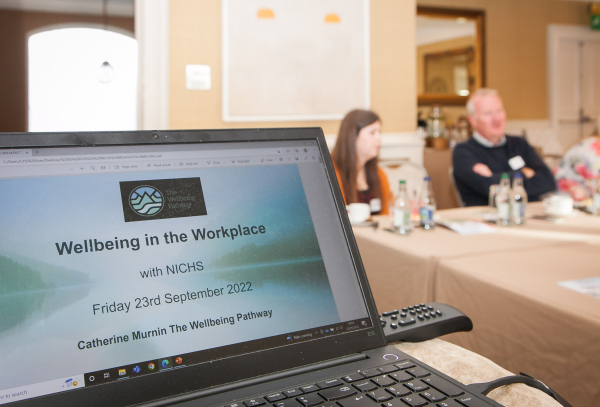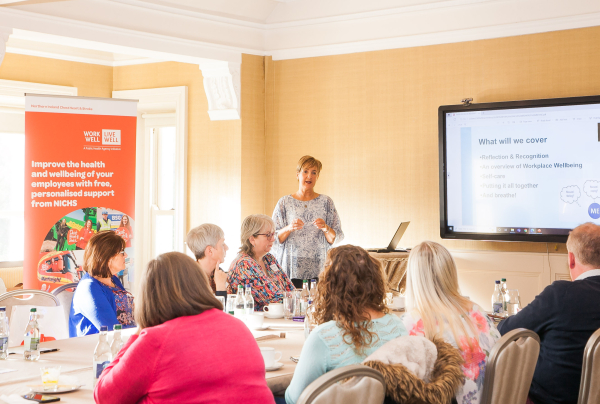
We recently held our Business Breakfast in Galgorm Resort & Spa as part of our Work Well Live Well programme. Staff from local organisations were invited to enjoy a healthy breakfast of delicious fruit and granola, while finding out more about the importance improving workplace wellbeing and embedding this into the culture of their organisations.
Attendees heard from Catherine Murnin from the Wellbeing Pathway, who spoke about introducing workplace wellbeing to your organisation, and Lesley from the Mid & East Antrim Borough Council who got us moving with some taster sessions of practical health and wellbeing initiatives like desk-based yoga.

Why do we need healthy workplaces?
‘Workplace Well-being’ is a buzzword that has gained a lot of interest recently but why is it important?
Research by numerous organisations including the World Health Organisation, Health & Safety Executive and the Department for Work and Pensions highlights that effective workplace health programmes can make a real difference not only to the health and wellbeing of employees and the business, but also the wider communities in which people live and work.
It has been shown that promoting health in the workplace:
- improves the working environment
- can reduce illness-related absence
- can help reduce staff turnover
- and can increase motivation among staff.
Organisations may also report measurable increases in the quality of products and services, more innovation and creativity, and a rise in productivity. This in turn can help improve the public image of the organisation and make it more attractive as an employer, which is vital in the current candidate- driven job market.
How to become a healthy workplace?
As our attendees learned at our Business Breakfast event, embedding workplace well-being into a company’s culture is unfortunately more complicated than simply serving up a healthy breakfast.
CIPD (the professional body for HR and people development) explain that an effective employee wellbeing programme should be at the core of how an organisation fulfils its mission and that every organisation’s approach to improving wellbeing should be strategic. To create a healthy workplace, an employer needs to ensure that its culture, leadership and people management are a steady base on which to build a fully integrated wellbeing approach.
There’s no 'one-size-fits-all' approach to designing a health and wellbeing strategy; its content should be based on the unique needs and characteristics of the organisation and its workforce. It’s also important that the organisation seeks employee feedback, so it can learn how to shape existing initiatives and plan new ones.
It is also key that employees feel empowered to look after their own health and wellbeing, by actively participating in the initiatives on offer in the workplace and taking care of their health and wellbeing outside work as well.
Senior managers are crucial role models, with staff more likely to engage with health and wellbeing activities with support and participation from senior management. This ensures health & wellbeing is a strategic priority embedded in the organisation’s day-to-day culture.

How can NICHS support organisations to introduce wellbeing in the workplace?
Work Well Live Well is a free workplace health and wellbeing support programme funded by the Public Health Agency (PHA) and delivered by Northern Ireland Chest Heart & Stroke (NICHS). The programme is centred around the World Health Organization (WHO) framework as an evidence-based approach for developing a workplace health strategy.
According to the WHO, the definition of a healthy workforce is one in which workers and managers collaborate to use a continual improvement process to protect and promote the health, safety and wellbeing of all workers by focusing on:
- Health and safety concerns in the physical work environment (e.g. regular and ongoing risk assessments; health and safety policies)
- The psychosocial work environment, including organisation of work and workplace culture (e.g. human resource policies that cover health and wellbeing, work/life balance)
- Personal health and resources in the workplace (e.g. healthy food choices; health checks and assessments in the workplace)
- Ways of participating in the community to improve not only the health of workers, but also their families and other members of the community (e.g. involving local suppliers; working to reduce the organisation’s carbon emissions and waste)
The aim of Work Well Live Well is to help local workplaces to improve the health and wellbeing of their employees through personalised support across these key areas.
The programme begins by supporting organisations to carry out a health and wellbeing survey in the workplace, analysing the results to determine health priorities and subsequently developing a bespoke, 3-year health action plan designed specifically for the workplace.
With the help and support of our talented Work Well Live Well team, a simple healthy breakfast can become part of a comprehensive, strategic and effective workplace wellbeing strategy that will benefit both the organisation, and its employees!
For more information on the programme please contact workwelllivewell@nichs.org.uk or visit www.nichs.org.uk/workwelllivewell.
References
World Health Organisation (2010) WHO healthy workplace framework and model. Available at: https://www.who.int/publications/i/item/who-healthy-workplace-framework-and-model
Department for Work And Pensions (2008). Working for a healthier tomorrow: work and health in Britain. Available at:
www.dwp.gov.uk/docs/hwwb-working-for-a-healthier-tomorrow.pdf
Health and Safety Executive (2007) Managing the causes of work-related stress: A step-by-step approach using the Management Standards. Available at: https://safetyresourcesblog.files.wordpress.com/2014/10/managing-the-causes-of-work-related-stress-a-step-by-step-approach-using-management-standards.pdf
CIPD (2022) Wellbeing at work. Available at: https://www.cipd.co.uk/knowledge/culture/well-being/factsheet
Public Health Agency (2020). Health and wellbeing at work A resource guide. Available at: https://www.publichealth.hscni.net/sites/default/files/2020-09/WorkWell_LiveWell_Resource_Guide_09_20%20no%20appendix.pdf
